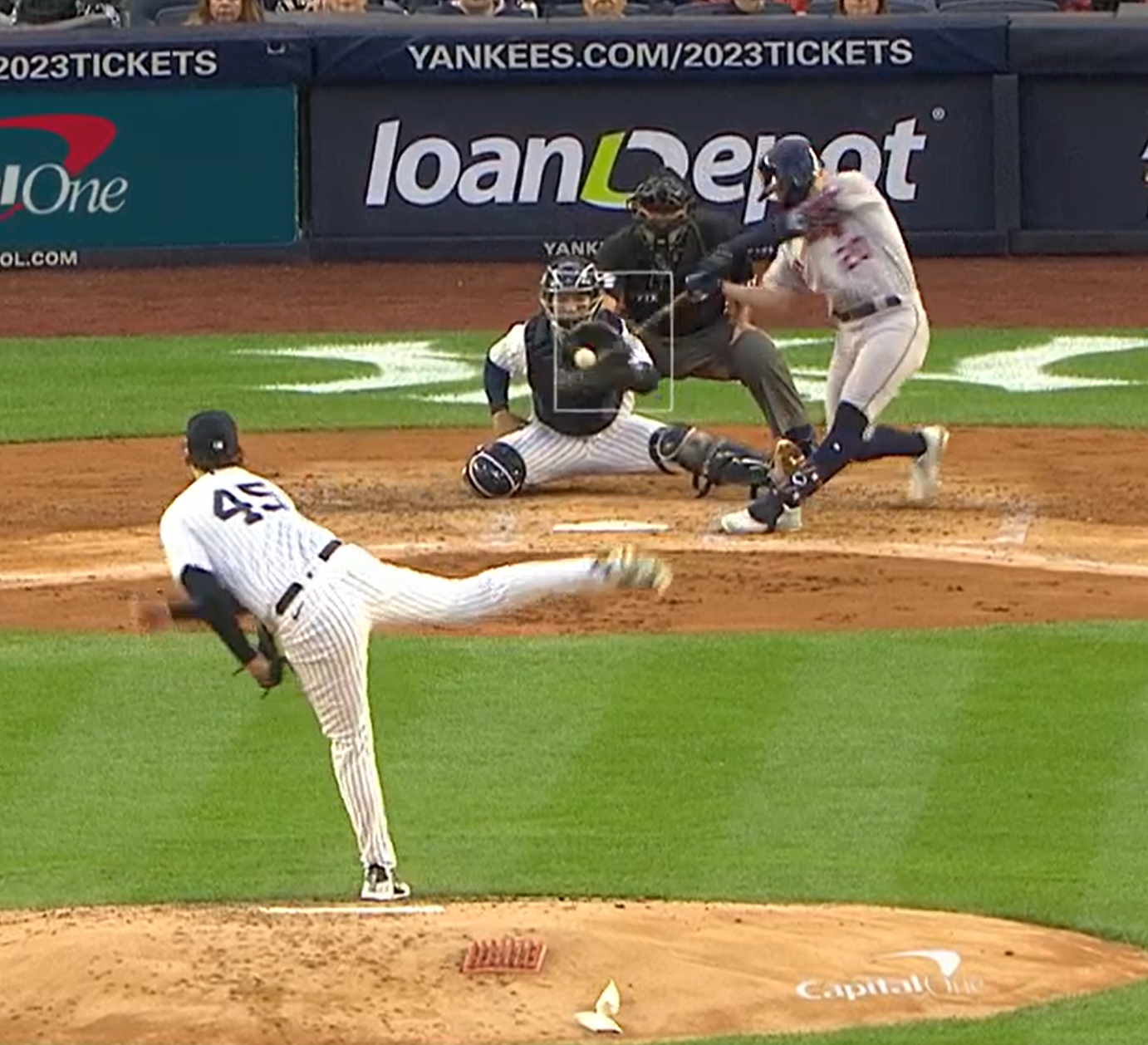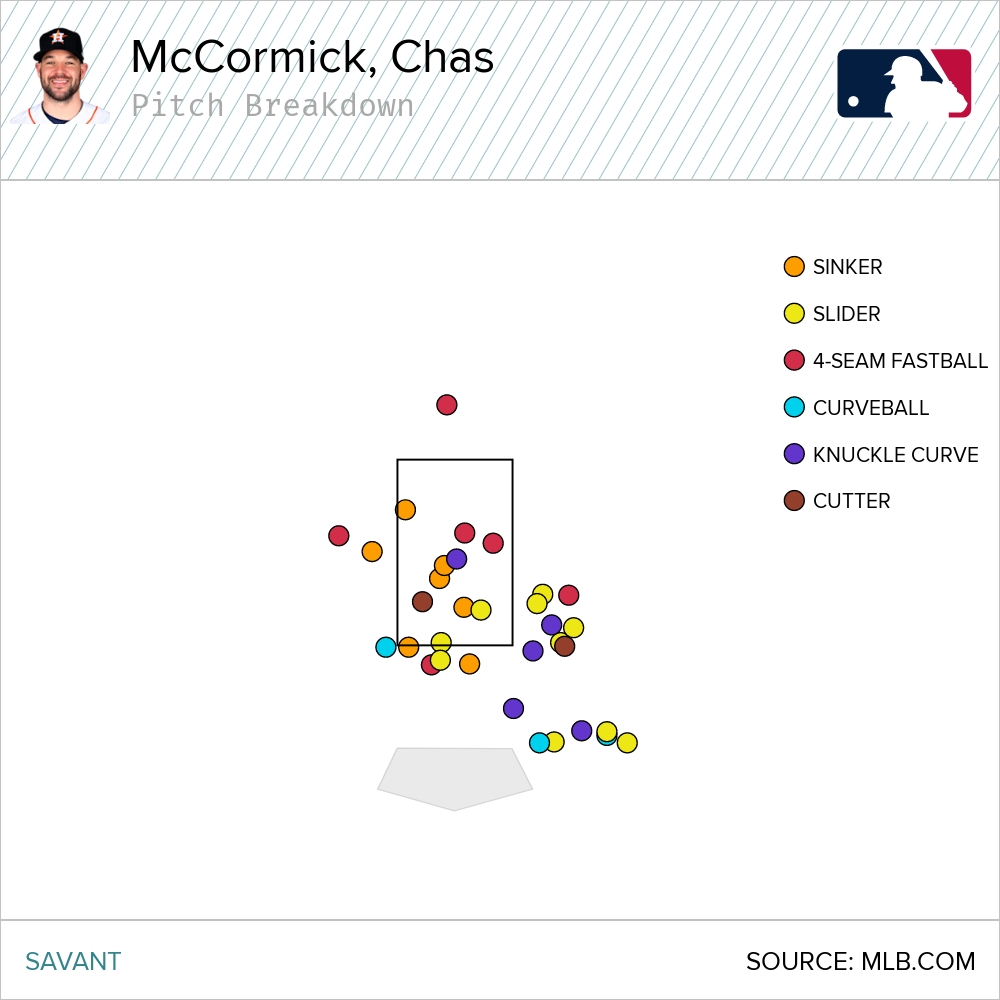Why Chas McCormick Loves Going Oppo (and Needs It To Survive)

There were a few times during the ALCS when I glanced up at a game and mistook Chas McCormick for Jose Altuve. Why? Both he and McCormick don’t set their feet in the box like a typical hitter would. Instead, they have distinct foot placement which aligns their front shoulder with the right fielder instead of the typical alignment with the center fielder. In McCormick’s case, it’s more pronounced than that of Altuve. And that’s not just in the setup; it includes the extent to which the Astros outfielder strides closed as well.
Every hitter, player, human, etc. has a different body. Depending on one’s body and its strengths and limitations, different adjustments need to be made to get the most out of that body when it comes to swinging a baseball bat. You may think it’s weird or ugly, but that doesn’t matter. McCormick’s closed setup and stride unlock a part of his game that he otherwise would not have. During the ALCS, I progressively came to realize he is a dangerous hitter when he drives the ball to the opposite field. If you pitch to his strengths that play into his inside-out bat path, then he can get lift on the ball and pepper the short porch in Minute Maid Park.
I hadn’t watched McCormick too much this season before the playoffs, but when I did, I didn’t recall such a pronounced closed stride. I had to investigate it more to figure out if it had been a mid-season adjustment, or if I hadn’t looked hard enough. Here’s a few swings from a series against the Yankees in July against both a righty and a lefty:
Both swings resulted in barrels to the right field gap. In the first one, he scorched a liner off Jordan Montgomery’s above-average changeup in the bottom of the zone. This isn’t an easy pitch to get your barrel under, but he did anyway. Similarly, McCormick laced Jonathan Loáisiga’s demon 2-seam fastball that most hitters have trouble hitting hard, let alone into the oppo gap. These aren’t normal opposite-field line drive outs; the intent in the mechanics and pitch selection was to drive the ball to right field, something you do not see from many above-average right-handed hitters.
Slightly closed strides are normal, but McCormick takes it to the next level. The stride and scissor kick finish looked the most extreme against Montgomery and is perhaps a good mechanical explanation for why he is more successful against lefties. Long story short, these two swings made me pay attention to his ability to shoot balls to the oppo gap. They also came near the beginning of a solid stretch of hitting that went through July and the second half of the season, where McCormick put up a 125 wRC+. And as his performance shot up, so did his tendency to go to the opposite field:
| Month | Oppo Batted Balls | Total Batted Balls | Percentage | wOBA | xwOBA |
|---|---|---|---|---|---|
| April | 17 | 51 | 33.3 | 0.196 | 0.207 |
| May | 9 | 45 | 20 | 0.276 | 0.206 |
| Jun | 3 | 19 | 15.8 | 0.691 | 0.212 |
| Jul | 20 | 49 | 40.8 | 0.673 | 0.574 |
| Aug | 15 | 37 | 40.5 | 0.478 | 0.421 |
| Sep/Oct | 14 | 53 | 26.4 | 0.549 | 0.424 |
| Postseason | 4 | 19 | 21.1 | 1.257 | 0.839 |
It’s a quirky skill. Many hitters in today’s game end up hitting their peak when they figure out how to pull the ball in the air consistently. McCormick has done the opposite in his first two seasons at the big league level. The two months with 40% of his batted balls going to the opposite field would put him at the top of the Oppo% leaderboard by over three percentage points. And to be frank, most of the other hitters there aren’t sluggers; they’re ground ball hitters.
This batted ball tendency and mechanical quirk of striding closed puts McCormick in an interesting position relative to his peers. None of that, though, necessarily speaks to why it works for McCormick and not others. There are several hitters across the league who stride slightly closed, like his teammate Altuve, but not all of them do it so drastically. Why is it that it works so well for him?
To answer that question, I’ll bring it all the way back to the fundamentals of hitting. Here is the simplest physics lesson you’ll ever get. We have the plane of the baseball and the plane of the bat. The plane of the bat must meet the bottom portion of the ball if the end goal is to elevate. Now, in the context of a hitter’s mind and body, they must get the barrel extended away from their torso to accomplish this task, but it’s not as simple as it sounds. While extending your barrel out, there are several things you must do, but I’ll stick to two for now. First, your bottom hand must point upwards. This will put your bat on the right path to drive up and through the ball. Next, your lower half must be in a strong enough position so that your hands and wrists can impact the ball and follow through in the right direction. This is the part that varies from hitter to hitter.
For most, this is done with your feet landing near neutral in either direction. By that I mean: if there were a straight line drawn from the top to the bottom of the batter’s box, both of the hitter’s feet would land just near that line with some room to the left or right. McCormick is far, far off from that mark; instead, he ends with one foot in the top right corner and one in the bottom left corner. That is as scissory as scissor kicks can get. This swing against Gerrit Cole serves as a nice visual reminder for how much McCormick angles himself in the box:
By doing this, McCormick can keep his hips closed for as long as they need to be, with his lower half balanced throughout each phase of the swing and his arms in the right direction to launch the ball in the air to the opposite gap.
In each of the three clips shown so far, the location was in the middle of the lower third of the zone. This is the ideal location for McCormick to lift the ball to right field. His angled body alters his bat path to the point where his finish works through the right-center gap. This screenshot gives you the ideal representation of what this looks like in practice:

Even as a proponent of striding closed and/or scissor kicking, this is still shocking to see. Call me crazy, but this is the anti-Tony Batista that I’ve been waiting my entire life for: start closed, stride closed, scissor kick yourself even further closed.
McCormick has found himself in unique territory, and it makes me wonder if this is a unicorn trait, like a pitcher with outlier run or ride. But there is always a flip side to unique traits when it comes to hitting mechanics. While this swing makes sense for McCormick, it does still give him a hole or two. After all, he’s Chas McCormick, not Mike Trout. And the playoffs are a perfect micro sample for how this type of hole could be exposed. In trying to diagnose where this limitation lies, I was reminded of a swing McCormick took against Loáisiga in the ALCS:
To hit a pitch with this shape, tilt, and run in the inner third, McCormick has to catch the ball so far out in front of the plate that it may be completely unnatural or impossible to do so. There isn’t any space in his bat path to accommodate hitting this if he is striding drastically closed. It makes any right-handed pitcher with this type of arm side run a very tough matchup for him, and is also why he excels so well against lefties.
I’m sure you’re asking now: how does this relate to what the Phillies’ pitching strategy has been or will be against McCormick? See for yourself:

First, all these pitches came against righties. Other than Ranger Suárez, I don’t imagine McCormick will face a lefty unless the Phillies have no choice (i.e., they probably won’t use José Alvarado or Brad Hand against him). Second, there are a whole lot of sliders low and/or low and away. One thing I haven’t noted thus far is that McCormick is abysmal against breaking balls; he hit .090 against sliders this year and .143 against curveballs. That’s good reason to throw them until he proves he can lay off. In terms of fastballs, there are some misses mixed in, but Seranthony Domínguez, Aaron Nola, and Zack Wheeler have done a quality job at targeting the inner third where McCormick’s limitation is. So far in the World Series, he has two hits: one a chopping grounder up the middle, the other a 63.2 mph jam shot. (It’s the red dot in the pitch chart all the way inside.)
There’s a pitcher on the Phillies, too, who seems uniquely well suited to countering McCormick: Noah Syndergaard, who excels at keeping righties in the ballpark to the opposite field. On the year, he allowed one double and zero home runs on his sinker to right-handed hitters going to right field. That’s a super small sample, but it’s valid given McCormick’s swing type and approach at the plate. There is perhaps no Astros hitter better suited to take Syndergaard deep to right if he does indeed make a mistake in a hot spot, but again, the stars would need to align perfectly.
I’m interested to see if McCormick slightly adapts his stride in anticipation of facing Syndergaard, or if he sticks to what has worked and lets the game come to him. Either is a fine approach, but he must have full conviction in it. I’m not sure if he is thinking as deep into it as I have in this piece, but I know the Phillies’ staff is prepared not to let him be the one that beats them. To do that, they must pound him inside, and not let his unique bat path come back to bite them.
Esteban is a contributing writer at FanGraphs. One of his main hobbies is taking dry hacks every time he sees a bat.

McCormick’s swing is so closed, his going oppo is like any other hitter going dead center. Looks like he’s trying to hit a pitcher throwing from a mound somewhere near first base. So fascinating to see the diversity of approaches different hitters can have to be successful in a way that works for them!